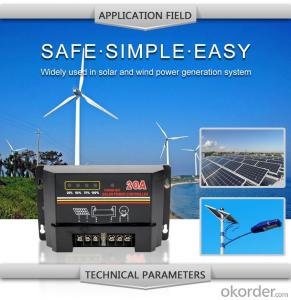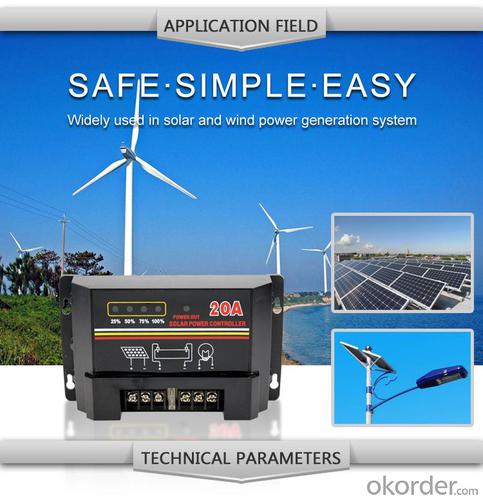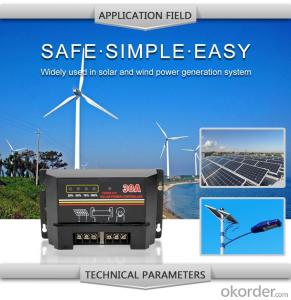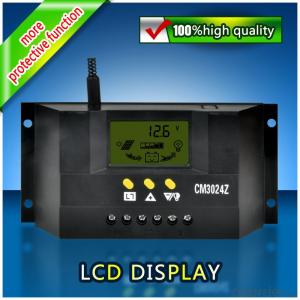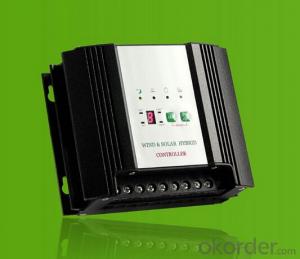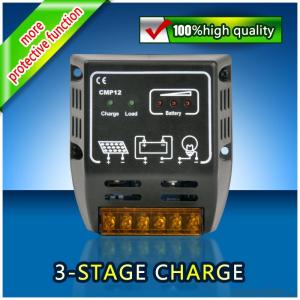Pwm 30A Solar LCD Controller with Best Price Hot Selling Model DM120A
- Loading Port:
- China main port
- Payment Terms:
- TT or LC
- Min Order Qty:
- 1 unit
- Supply Capability:
- 10000 unit/month
OKorder Service Pledge
OKorder Financial Service
You Might Also Like
Production Introduction
Solar controller is control device which can control solar panel and transform solar energy into electricity then store to the battery bank. Solar controller is the most important part in offgrid system, whose performance has much effect on life expectancy and operation of the whole system, especially the battery expectancy.
Application Areas
Standalone Photovoltaic power station
Standalone Domestic household photovoltaic power system
Mobil communication base stations, expressway and other non-residential regions.
Coastal islands, remote mountainous, border posts for regions shortage of or without electricity.
Government demonstration projects, landscape lighting project etc.

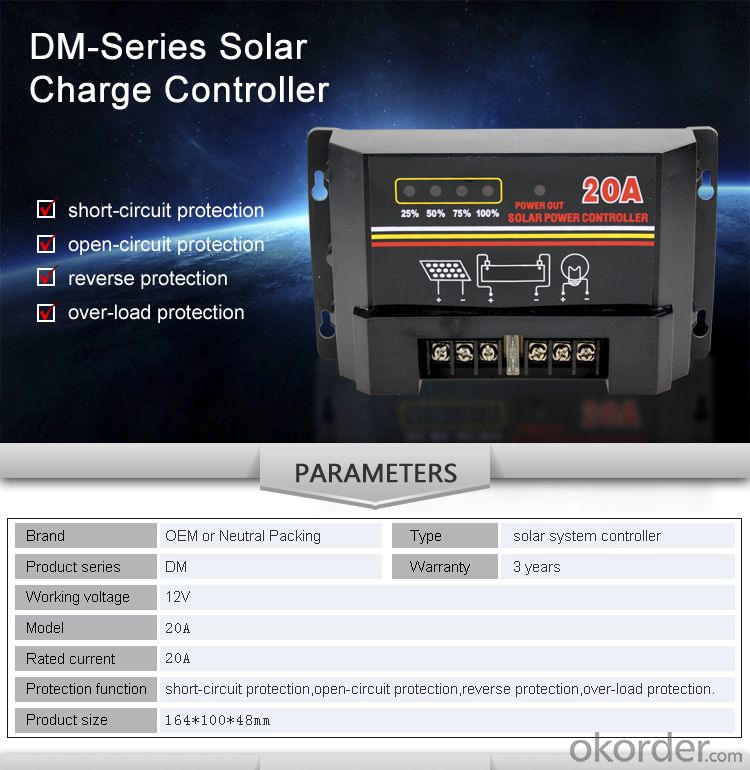
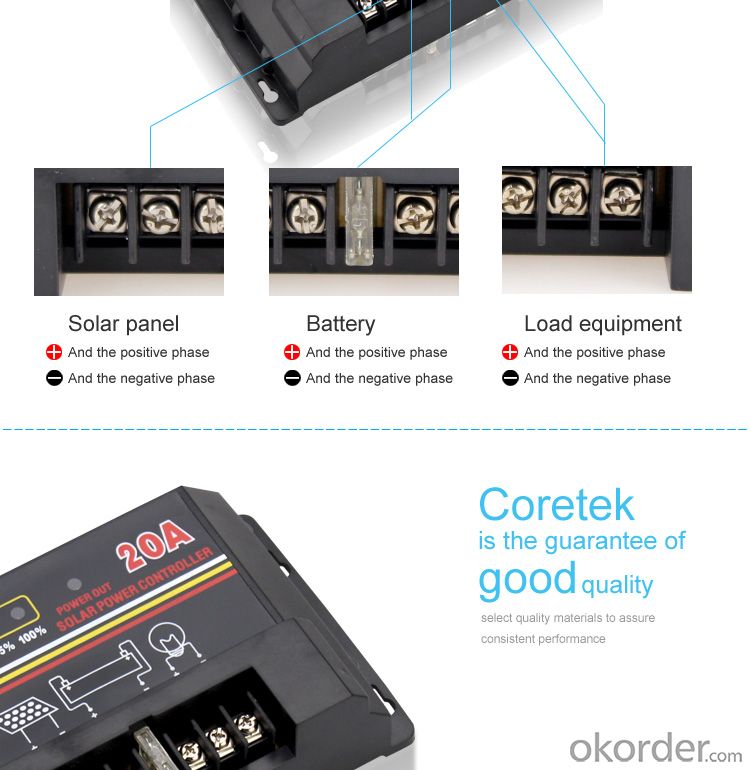
- Q: Can a solar controller be used in a solar-powered interplanetary travel system?
- Yes, a solar controller can be used in a solar-powered interplanetary travel system. A solar controller regulates the flow of electricity from the solar panels to the batteries, ensuring efficient charging and preventing overcharging. In an interplanetary travel system, where solar power is the primary source of energy, a solar controller would play a crucial role in managing and optimizing the power supply to the spacecraft's systems.
- Q: How does a solar controller handle shading or partial shading of solar panels?
- A solar controller handles shading or partial shading of solar panels by utilizing a technology known as Maximum Power Point Tracking (MPPT). MPPT allows the controller to continuously monitor and adjust the operating point of the panels to ensure they are operating at their maximum power output, even when shaded. This technology enables the controller to optimize the energy generation of the panels by dynamically adjusting the voltage and current levels to minimize the impact of shading and maximize overall system efficiency.
- Q: Can a solar controller be used with a solar-powered electric vehicle charging station for public use?
- Yes, a solar controller can be used with a solar-powered electric vehicle charging station for public use. A solar controller helps regulate the flow of electricity from the solar panels to the charging station, ensuring efficient charging and protecting the batteries from overcharging. It also allows for monitoring and control of the charging station's performance.
- Q: Can a solar controller be used with a solar-powered recreational facility?
- Yes, a solar controller can be used with a solar-powered recreational facility. A solar controller regulates the flow of electricity from the solar panels to the battery bank, ensuring efficient charging and preventing overcharging or damage to the batteries. It is an essential component in managing the power supply for a solar-powered facility, including recreational facilities such as campsites, sports complexes, or outdoor activity centers.
- Q: How does a solar controller prevent damage from power surges?
- A solar controller prevents damage from power surges by regulating the flow of electricity and ensuring a stable voltage output. It contains protective components such as surge arresters and transient voltage suppressors that divert excess energy away from the system, preventing it from reaching sensitive components and causing damage. Additionally, some controllers have built-in circuitry that automatically shuts down the system in case of a power surge, further safeguarding the solar panels and other connected devices.
- Q: Can a solar controller be used with solar arrays of different voltages?
- Yes, a solar controller can be used with solar arrays of different voltages. Solar controllers are designed to regulate the charging of batteries from solar panels, and they typically have the capability to handle a range of input voltages. They are equipped with features like voltage regulation and maximum power point tracking (MPPT) to ensure compatibility with various solar array voltages.
- Q: Can a solar controller be used with a solar-powered electric fence energizer?
- Yes, a solar controller can be used with a solar-powered electric fence energizer. A solar controller helps regulate and control the flow of energy from the solar panels to the energizer, ensuring optimal charging and performance of the electric fence system.
- Q: Can a solar controller be used in a community solar system?
- Yes, a solar controller can be used in a community solar system. A solar controller is a crucial component that regulates and optimizes the charging of batteries in a solar system, regardless of its scale. In a community solar system, where multiple households or buildings are connected to a shared solar array, the solar controller ensures the efficient distribution of solar energy and manages the charging and discharging of batteries effectively.
- Q: What is the maximum number of load control timers supported by a solar controller?
- The maximum number of load control timers supported by a solar controller can vary depending on the specific model and manufacturer. However, many solar controllers typically support multiple load control timers, ranging from around 10 to 30 timers or even more in some advanced models.
- Q: How does a solar controller handle temperature fluctuations in the environment?
- The purpose of a solar controller is to manage temperature fluctuations in the environment through the utilization of various mechanisms and features. Regulating and optimizing the charging and discharging of batteries in a solar power system is one of the primary functions of a solar controller. To guarantee efficient operation in varying temperatures, solar controllers typically incorporate temperature sensors. These sensors monitor the surrounding temperature and provide feedback to the controller. Based on this information, the controller can adjust its charging and discharging parameters accordingly. In cold temperatures, the solar controller may increase the charging voltage to compensate for reduced battery performance. This prevents insufficient charging and ensures that the batteries receive the necessary charge. Additionally, the controller may modify the charging algorithm to allow for a longer absorption phase, which aids in fully charging the batteries even at lower temperatures. On the other hand, in hot temperatures, the solar controller may decrease the charging voltage to prevent overcharging and potential damage to the batteries. It may also shorten the absorption phase to prevent excessive heat buildup. These temperature compensation techniques assist in maintaining optimal battery performance and prolonging their lifespan. Moreover, advanced solar controllers may include additional features to mitigate temperature-related issues. For example, some controllers are equipped with temperature sensors specifically for the solar panels themselves. These sensors monitor the panel temperature and adjust the maximum power point tracking (MPPT) algorithm accordingly. By optimizing the panel's output voltage and current based on temperature, the controller ensures maximum energy conversion efficiency. In conclusion, a solar controller effectively manages temperature fluctuations in the environment by utilizing temperature sensors and implementing temperature compensation techniques. This enables the controller to adapt its charging and discharging parameters to different temperature conditions, ensuring optimal performance and longevity of the batteries in a solar power system.
Send your message to us
Pwm 30A Solar LCD Controller with Best Price Hot Selling Model DM120A
- Loading Port:
- China main port
- Payment Terms:
- TT or LC
- Min Order Qty:
- 1 unit
- Supply Capability:
- 10000 unit/month
OKorder Service Pledge
OKorder Financial Service
Similar products
Hot products
Hot Searches
Related keywords
